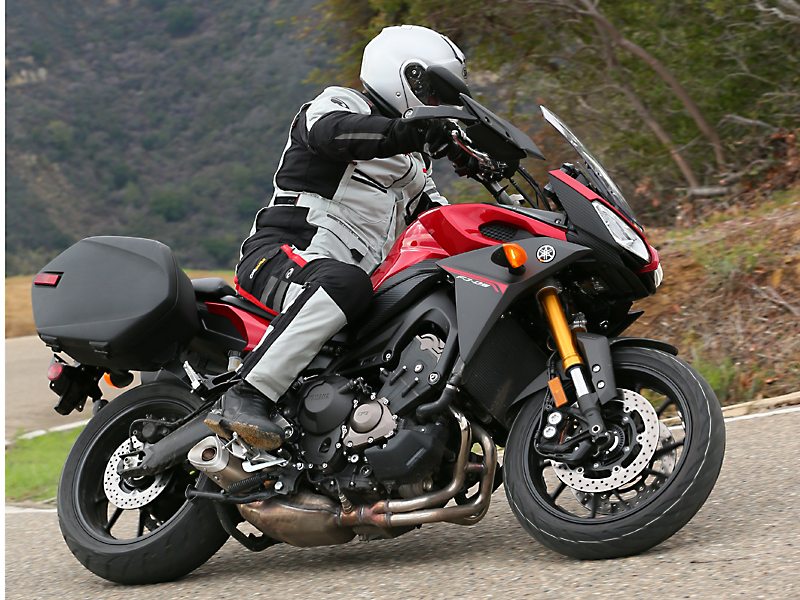
Photography by Riles & Nelson
What are you looking for in a sport-touring motorcycle? I know what I want in my go-to bike—plenty of performance, so I can cruise at high speed, make quick passes, get out of harm’s way in a hurry and have some fun on back roads. Riding comfort didn’t used to matter to me much, but then neither did a high-fiber diet and an extra firm mattress—now all three are requirements. A bike that’s nice and light so it handles well and I don’t pull something pushing it around would be great, and I want standard features like wind protection, a centerstand and ABS brakes. Decent fuel economy and capacity are musts, and—since you asked—hard saddlebags and a luggage rack would be great for sport-touring, even as options.
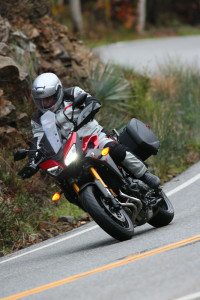
Think this bike doesn’t exist? Or if it does, it’s too big and costs too much? Not any more. The Yamaha FJ-09 you see before you offers all of the above and then some. With its 4.8-gallon tank full and equipped with optional 22-liter saddlebags and heated grips, it weighs just 493 pounds. At its heart there’s the liquid-cooled, transverse 847cc triple from the very successful FZ-09, an absolute ripper of a motor, even with its ECU settings tweaked for sport touring. And the base price is just $10,490, so the FJ-09 is lighter and costs less than the larger sport-touring competition.
While its FZ-09 predecessor is the choice for a mostly solo rider who simply wants sporty performance with upright seating, some cool styling and a low price tag ($8,190), the FJ-09 adds some versatile sport-touring features for more comfortable commuting and touring, solo or two-up, without piling on weight and substantial cost. To keep costs down, it shares its engine, cast aluminum frame and curvaceous, braced swingarm with the FZ-09; it’s longer seat subframe (for supporting a passenger and saddlebags) adds 5.1 inches to the FJ-09’s overall length. The adjustable seat is also higher at 33.3 and 33.9 inches, and the tubular handlebar is 0.8-inch higher, 0.7-inch closer to the rider and 1.6 inches wider for a more open riding position. While its Transformer-like dual-headlight face and new front and side fairings wear adventure-bike style, Yamaha stopped short of giving the FJ-09 any off-road chops and focused on its street cred.
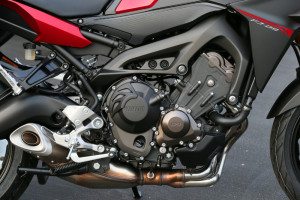
To that end the bike wears Dunlop Sportmax Roadsmart II tires that are said to offer longer life, and I can attest to their stickiness and great performance in the rain. No effort was made to change or tuck the under-slung 3-into-1 exhaust up out of harm’s way for riding over off-road obstacles. And the KYB 41mm upside-down fork has adjustable preload and rebound damping like the FZ-09’s, but its compression and rebound damping rates have been increased 1.5 and 2.5 times overall, respectively, to handle added touring weight (like a passenger, bags and gear). In back, the KYB linked rear shock also offers adjustable spring preload (via a ramped collar) and rebound damping, and has 2.5 times more compression and 2 times more rebound damping overall compared to the FZ. Travel remains a generous 5.4 and 5.1 inches front and rear.
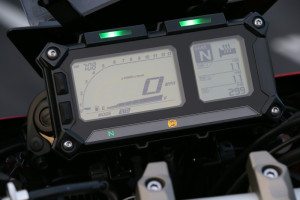
Although the FZ-09 is a comfortable motorcycle, the taller, wider bar and increased legroom of the FJ-09 make it better for staying in the saddle from fill-up to fill-up. The seat is definitely high (and some may find it a bit too hard), and even in the low position with my 29-inch inseam I’m on just the balls of my feet, but it’s narrow in front so it’s easier to get your feet down. The windscreen is smallish but does a good job of keeping the wind off your chest and reduces fatigue, though it’s 2-inch adjustment range did not make a noticeable difference to me—as soon as we try the optional touring windscreen we’ll update this story. We also have yet to try the passenger accommodations, but the seat is reasonably wide, seems nicely shaped and is flanked by large grab handles. Overall so far, the bike approaches the road comfort and suspension compliance of a larger adventure-touring machine while being much more nimble.
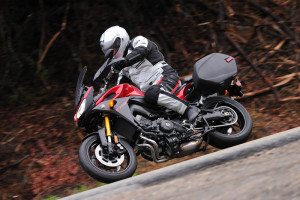
And quick! The FJ-09 requires premium fuel, but with 11.5:1 compression in the DOHC, four-valve-per-cylinder engine, the triple can become a snarling beast when desired, and Yamaha’s tuning tricks have also given the powerplant incredible midrange, with a claimed 65 lb-ft of torque. Even climbing around in the canyons you can leave it in fourth gear and cruise smoothly from corner to corner, or drop it a gear or two and wring its neck—it will respond with massive urge. The bike also features the Yamaha D-MODE (Drive Mode) variable-throttle-control system, which allows the rider to choose Standard, sporty A or mellow B modes to dial-in the engine character for the riding situation. (Importantly, Yamaha says that both the 2015 FZ-09 and FJ-09 throttle-by-wire and ECUs have been tweaked to improve their throttle response, making them less abrupt, which was a complaint on the new-for-2014 FZ-09). In A mode the engine responds very quickly for shooting from corner to corner. Standard mode provides smooth and even power delivery for most riding, and B mode mellows out the throttle response for the rain and slippery conditions. Switchable ABS and traction control are standard, too, which doubles-up the amount of confidence the bike inspires in the wet.
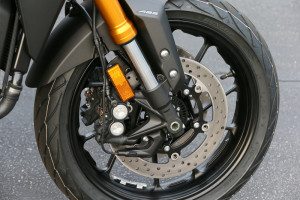
Although some buzziness creeps into the seat and bars at high revs, for the most part the FJ-09 responds smoothly and willingly to whatever you ask of it. Its 6-speed transmission shifts cleanly and the clutch has good feel, too. The bike will zoom down the highway at 80 mph all day long, and its exceptional low- and high-speed handling make it both easy and thrilling to ride, in part thanks to that wide handlebar, which can be adjusted forward or back 0.4-inch. Ground clearance is generous, and the triple disc brakes are strong and linear, though they could use a touch more strength in front and less pedal travel in back.
Adding to the standard niceties are adjustable levers, hand guards and super-bright LED headlights with easy-to-reach adjusters. The LCD dual-screen meter is easy to read, and Yamaha will offer a complete range of 30 custom accessories including a rear rack, top case, side cases, a taller windscreen, heated handgrips and both lower and Comfort Saddle seats. While the 22-liter bags are 3 inches narrower than the FJR1300’s and won’t quite hold a full-face helmet, they are still plenty useful, and their slim profile makes slipping through traffic a breeze.
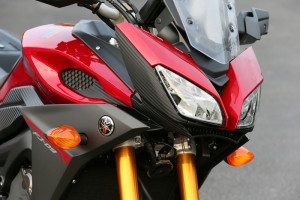
The 2015 Yamaha FJ-09 will be available in two color options, Matte Gray and Candy Red. At $10,490, even after adding the cost of accessories like the saddlebags and mounts at about $1,000, for someone who isn’t interested in riding off-road the FJ-09 is priced much lower than the competition and is a great value, with the only downsides perhaps being chain final drive maintenance and less load capacity. But for most it’s going to be a lot easier to ride than those bigger bikes, not to mention pick-up should it fall over….
(Happy Holidays! We’ll update this report with dynamometer and fuel economy figures after we’ve had a little more time with the bike. The trip computer has so far recorded an average of 45.1 mpg. On the Jett Tuning dyno, our last FZ-09 test bike made more than 110 horsepower and 63 lb-ft of torque, though the FJ-09’s ECU has been tweaked to give the bike more low-end and midrange.)
2015 Yamaha FJ-09

Base Price: $10,490
Price as Tested: Approx. $11,790 (saddlebags, mounts, heated grips)
Warranty: 1 yr., unltd. miles
Website: yamaha-motor.com
Engine
Type: Liquid-cooled, transverse in-line triple
Displacement: 847cc
Bore x Stroke: 78.0 x 59.1mm
Compression Ratio: 11.5:1
Valve Train: DOHC, 4 valves per cyl.
Valve Insp. Interval: 26,600 miles
Fuel Delivery: Denso EFI w/ YCC-T & 41mm throttle bodies x 3
Lubrication System: Wet sump, 2.85-qt. cap
Transmission: 6-speed, cable-actuated wet clutch
Final Drive: O-ring chain
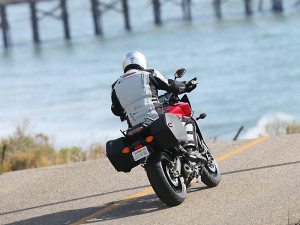
Electrical
Ignition: TCI/32-bit ECU
Charging Output: 415 watts max.
Battery: 12V 9.1AH
Chassis
Frame: Aluminum controlled-fill die-cast perimeter w/ cast aluminum swingarm
Wheelbase: 56.7 in.
Rake/Trail: 24 degrees/3.94 in.
Seat Height: 33.3/33.9 in.
Suspension, Front: 41mm upside-down fork, adj. for spring preload & rebound damping w/ 5.4-in. travel
Rear: Linked single shock, adj. for spring preload & rebound damping w/ 5.1-in. travel
Brakes, Front: Dual 298mm discs w/ opposed 4-piston calipers & ABS
Rear: Single 245mm disc w/ 1-piston pin-slide caliper & ABS
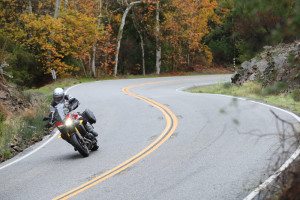
Wheels, Front: Cast, 3.5 x 17 in.
Rear: Cast, 5.5 x 17 in.
Tires, Front: 120/70-ZR17
Rear: 180/55-ZR17
Wet Weight: 493 lbs. (as tested)
Load Capacity: 367 lbs. (as tested)
GVWR: 860 lbs.
Performance
Fuel Capacity: 4.8 gals., last 1.0 gal. warning light on
MPG: 91 PON min. (low/avg/high) TBD
Estimated Range: TBD
Indicated RPM at 60 MPH: 3,900


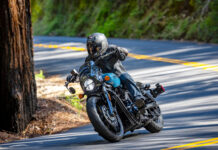





This would have been my next bike to replace my FJR except for one glaring omission. They removed the cruise control! The blanked off switch gear is even still there. I would have gladly paid a few hundred more for it. Now it looks like it’s going to the Triumph 800 XRX. To bad. The extra power would have been nice. But now that I have had CC I won’t buy a bike meant for touring without it.
I don’t understand it either, but with the blanked out control housing may hint that cruise may be offered in the future-doubt it will be something to retrofit to existing bikes.
Would have been good to see an FJ-09 Touring model that came set up with cruise, heated grips and saddlebags standard.
Add the factory bags & heated grips and you’re not too far out of reach for an FJR (that has cruise, but is a larger, heavier bike.)
To look past purchasing this bike on a mere luxury option could be the biggest mistake you make…it’s the perfect combination of mechanics and aesthetics…and it’s built by Yamaha. I am sick of people saying that it can’t be a touring bike because it doesn’t have “blank” or come with “blank” already installed or get “blank” miles to the gallon. The fact is, anyone can tour on any bike…i actually enjoy being connected to the bike. Your loss I guess.
I have to agree with the comment of not having cruise control and I wont buy a bike for touring if it doesn’t have it. Just about every manufacturer is offering cruise on every travel oriented bike that they sell. Yamaha may lose some sales to the Triumph XRX on this one. I too like to feel connected to a bike, but only in situations where I can use the performance of the bike. On long boring highways of the western USA, cruise control can be your best friend.
I just submitted a letter to the Yamaha legal department requesting that Yamaha equip the bike with cruise control. I urge anyone to do the same if they like that feature.
So when did the FJ 09 get the extra cylinder?
I noticed the same thing, maybe they copy a pasted a little to much info from an other bike? 😉
You are both correct. Our mistake. The text has been corrected online. Thanks for letting us know!
OK, I understand marketing to a category but why do many of these style bikes need to have seat heights so tall when they’re designed for street use? Riding two up puts the weight up high and reduces safety when putting your feet down. Not to mention they are unnecessarily cutting out a good percentage of buyers that can’t or don’t want to accommodate a seat height in the 33-34 inches range. Personally I’m 6′ tall and have had my license since 1973 but I would prefer a bike that’s more manageable for two,especially when stopped, or getting on and off the bike.
I do love a triple and have owned several from Triumph although my 1600 Thunderbird twin was a lemon and Triumph wouldn’t fix it because Colorado’s lemon laws don’t apply to motorcycles. I won’t buy another new Triumph because of their unconscionable warranty practices and back in the late nineties I even met with Triumph to explore opening a dealership with them. I’ve never had that kind of issue with a Japanese bike.
Stay safe out there.
Cary
With over 100 hp and 6 speeds, why does it need to turn 3900 rpm at 60 mph? I like low engine rpm at interstate speeds, like the old ST1100 bikes. But, I’d love to ride it. Owenership of a Triumph Tiger made me appreciate the triple engine and I’d like to ride Yamaha’s version.
It all smooths out at 80. You will find that 5000+ rpm is smoother and you may end up riding for mile after mile in 4th gear before you realize it.
This would have been the bike for me except they limited the top speed of this bike to 115mph in north America. This is a bitter disappointment that made me reconsider my purchase.
It also made me wonder if there is an inherent design flaw with the limit being reduced so low
I have to agree with the need of cruise control. I’m looking for a light weight sport tourer but I need cruise control because I’m getting arthritis in my hands and not being able to loosen my grip in my right hand is becoming a limiting factor to my riding. Otherwise this would be exactly what I’m looking for.
I like the Triumph Tiger XRX a lot but wish it had the HP of the Yamaha and wish it didn’t have such skinny tires for a road bike.
” The adjustable seat is also higher at 33.3 and 33.9 inches, and the tubular handlebar is 0.8-inch higher, 0.7-inch closer to the rider and 1.6 inches wider for a more open riding position.”
I have both the FZ and FJ, and just measured the triple tree with relation to the axle and the handlebars. On the FZ, the top of the triple tree is 31″ from the axle and 1-5/8″ to the center of the handlebars. The FJ is 32″ to the axle and 3-3/4″ to the center of the handlebars. Also the handlebars are the same, but the FJ has handguards that extend the handlebars width by it’s design.
Cruise control !!??? Get a grip, pun intended. It’s a SPORT touring bike and it’s inexpensive. Let’s keep it that way. Oh and it’s restricted to 115mph because of euro standards. Reflash the ECU and enjoy.